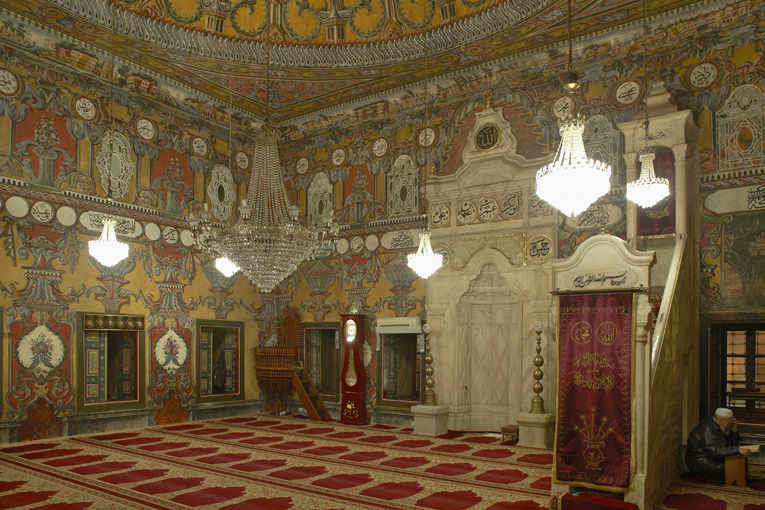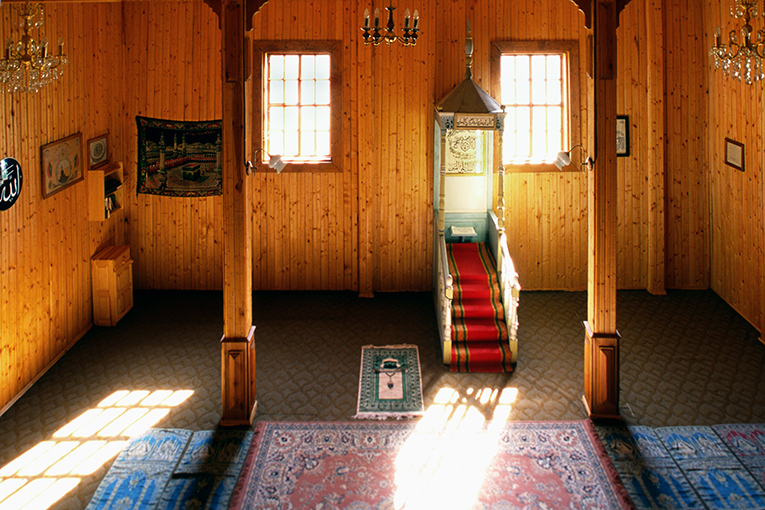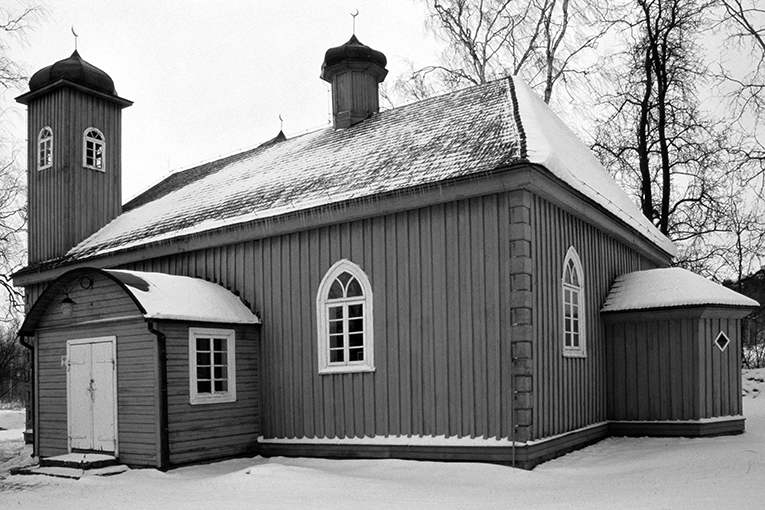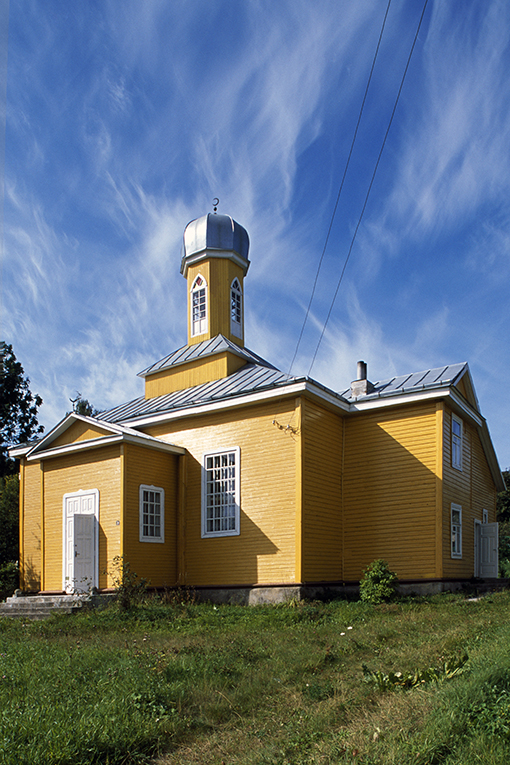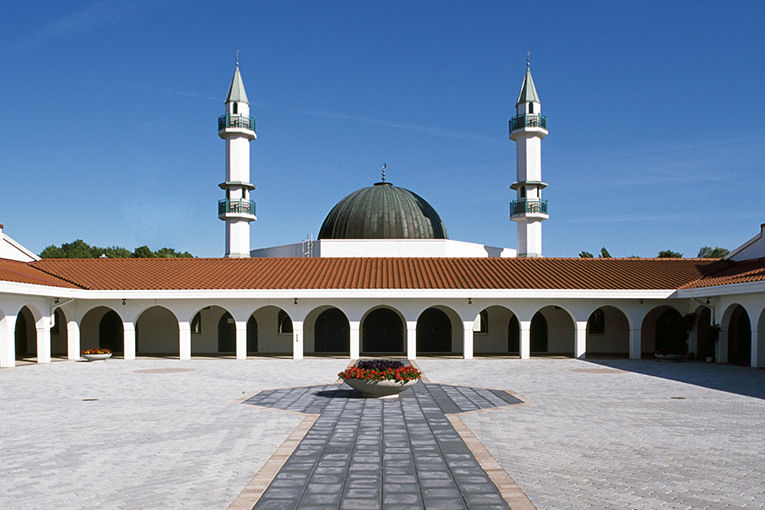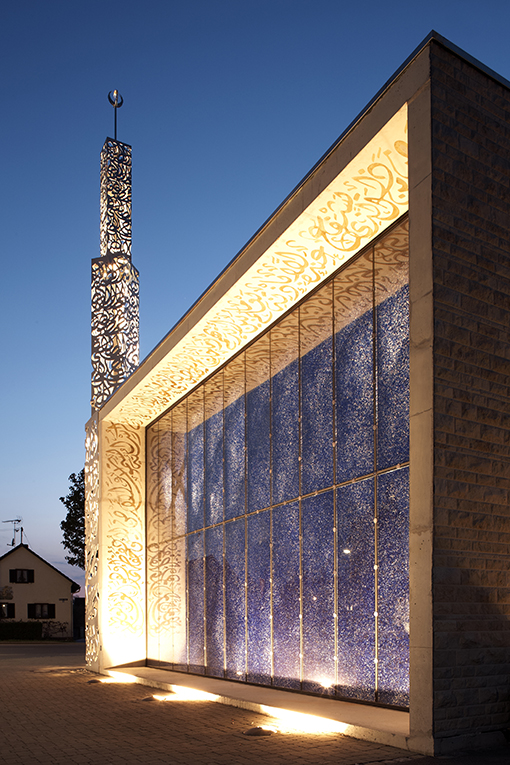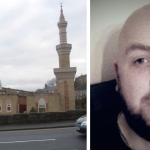Mosques have been visible in the European landscape for centuries, starting with the Moors in Spain:
Mezquita de los Andaluces Universidad Islamica Internacional Averroes de Al-Andalus in Cordoba, Spain. The city is one of the oldest in Spain, and was founded before the Roman time. After the Muslim conquest Cordoba was the capital of al-Andalus. It had also become a center for education and dialogue under its Islamic rulers. Al-Andalus is one of the few places in Western Europe where the Azan (Islamic call to prayer) is allowed in the public space.
Followed by the Ottomans in the Balkans:
The prayer hall of the Pasha Cammii, in Tetovo with indoor decoration. The Pasha Cammii, in Tetovo, Macedonia built by the end of the 15th century, is a representative example and unique artistic, achievement of an Ottoman religious building in Macedonia, with a specific outdoor and indoor decoration. For centuries this mosque has continuously preserved its religious and educational upbringing function with social and cultural meaning. Today´s architectural form and decoration were created after the second half of the 19th century (1833/34), when the renowned Abdurrahman Pasha of Tetovo ordered the reconstruction of the mosque, which was burned in the great fire that spread over the city by the end of 17th century.
And the Tatars in the Baltic region:
The prayer hall of the mosque in Keturiasdesimt Totoriu, Lithuania. The mosque of Keturiasdesimt Totoriu village (meaning the “Town of the 40 Tartars”), located just outside Vilnius city, was mentioned for the first time, written in the year 1558. It is the oldest mosque in Lithuania available for believers. The inhabitants were descendants of the Tatars from the Crimea, who had been brought over 600 hundred years ago as officers and bodyguards of a Lithuanian prince into the country.
The wooden mosque in Kruszniany, Poland was built in 1871 and is the oldest mosque in Poland. Over time, the “Lipka Tatars” lost their original Tatar language. As early as the 17th century, they were linguistically adapted to their Slavic environment. Today’s descendants of these Tatars speak Polish, Lithuanian, or a Belarusian dialect.
Most of the mosques, such as this one in Novogrudok, Belarus are built out of wood, owing to a regulation only allowing churches to be built out of stone, as a demonstration of Christian superiority over Islam. The wooden mosques have however evolved into a symbol and identifying attribute of the Lipka Tatars.
More recent additions have been made due to the arrival of migrants and refugees from Muslim countries. European engineers and architects have declared mosques some of the most beautiful architectural wonders in the world. This presents opportunities to add aesthetic value to the European cultural heritage. However, it is of critical importance the design of European mosques fits in with the European cultural heritage.
Specific criteria for the construction of mosques and minarets could be defined so as to integrate future mosques in the existing architectural heritage. The result should be greater support for the idea of adding the mosques to the public space, rather than banning them. This does not mean that European mosques must abandon a long and rich heritage. For example, while minarets are not fundamentally important to the construction of a mosque, they are of symbolic importance to the identity of many migrant and refugee Muslim communities in Europe, and they help to prevent a sense of cultural alienation.
The construction of large mosques in Western European symbolizes the existence of a new self-confidence in the Muslim community in Europe after decades of being in the shadows.
The mosque in Malmö, Southern Sweden, was set ready for believers in 1984. The project was financed by the governments of Saudi Arabia and Libya, and the Muslim community of Sweden as well. In the year 2002, the center was extended to include a school and two minarets. Fire broke out in the night of April the 28th. 2003. The whole center was destroyed except the prayer building and the minarets. More than 55.000 believers lost their center. According to the Swedish police, this was a crime of an arsonist. However in the summer of 2005 the Islamic center was rebuilt.
The mosque in Vienna, Austria was est. 1979, architect Richard Siegfried Lugner. Islam is legally recognized in Austria since 1912 and on this basis the Islamic Faith Community was founded. It has a reputable status and is the official institution to the Austrian State. The organization gets paid by the state a small sum of assistance, which is mainly used for the training of teachers. Members pay a kind of membership fee. No matter if you are a member or not, can be thought of as Muslim also official declare (there is no birth certificate as confirmation etc. but a confirmation, the faith community issuing a “strict orthodoxy” to certify that you can use, for example in the army (Friday prayer etc.). The Austrian “Islam law” was approved in 1912, were in the course of the annexation of Bosnia than about 1,000,000 Muslims became part of the monarchy. It is Europe’s only law of that kind.
The Umar Ibn Al Khattab Mosque in Berlin, Germany
This new visibility in the public space evokes criticism from mainstream society and contributes to the heated debate about the role of Islam in Europe. While some reject the construction of mosques out of hand, tolerant voices emphasize that mosques can also serve as venues for inter-religious and cultural exchange and transfer.
Mosques are a significant social platform for religious and cultural exchange and a sanctuary for individuals to explore and practice their beliefs. Mosques are also helping to make Islam visible, replacing undignified prayer sites in warehouses and basements. They show that Islam is part of Europe.
The role of the architectural design.
“What makes a mosque a mosque?” That’s easy: a wall that is exactly aligned to Mecca. So short and succinctly does the Kuwaiti designer and architecture, Professor Omar Khattab, define the characteristics of a Muslim place of prayer. The architecture of the mosque, while replete with traditions and references, has only a few aesthetic design requirements. That leaves the designer free to re-imagine how a mosque should look.
The old mosques from those regions of Europe, which at one time had been under Muslim rule, as well as the first immigrant mosques, live up to the stereotypical mosque. By contrast, mosques that have been recently build, along with those on the drawing board, take many of their cues from the surrounding ascetics and trends in modern European architecture while remaining true to core traditional values. Examples are the large mosque in Rome:
“Centro Islamico Culturale D´Italia” The mosque in Rome is one of the largest in Europe. This project was founded by 23 Arab and Islamic states. The mosque is a mixture of a modern architecture and old Islamic tradition. Architect: Paolo Portoghesi, Vittorio Gigliotti and Sami Mousawi. The “dispute” between the builder of the mosque and the Italian authorities was that the minaret was not allowed to be higher than the St. Peter’s Basilica in Rome.
The mosque in Penzberg in southern Germany:
The mosque is located in the little town Penzberg in South Germany close to the Alps and was ready in 2005. The architect is Alen Jaserevic from Bosnia and Herzegovina. The aim of the architect was to design a mosque added to the typical South German environment. In Germany it is normally not allowed calling to the prayer, therefore the Azan is “written” as calligraphy in the minaret. It is best to see in the evening, if the light is switched on.
The impending large mosque in Munich’s city center and Britain’s first green mosque in Cambridge.
Copenhagen has also recently added its first large purpose-built mosque, and plans on the drawing board for more:
The dome of the first large purpose-built mosque in Denmark: Hamad Ben Khalifa Civilisation Center, Copenhagen (2014) Architekt Metin Aydin.
These mosques incorporate architectural diversity, modernity, transformation and reinterpretation of the classic Islamic architecture. These mosques have emerged as a new and self-contained European Islamic architecture. They express an identity where Muslims can exercise and develop their spirituality in a European context.
Text and photos by Ahmed Krausen. (©All rights reserved 2015/2016)
Ahmed Krausen lives and works as a freelance photographer in Copenhagen, Denmark. For over a decade, Ahmed has concentrated his photographic work on the physical manifestations of Islam in Europe. As a European Muslim and convert to Islam, Ahmed’s faith is the central inspiration for his photography. The focus of this project has to make the diversity of Islam in Europe visible. This is accomplished by combining of images of both ancient and modern mosques from different European countries, thereby giving a glimpse into Muslim lives in Europe. Ahmed´s photos have been displayed in many countries, including Germany, Italy, Cairo, London, and the United Arab Emirates. His work has also been used in numerous books and articles. His website: www.ahmedkrausen.com


